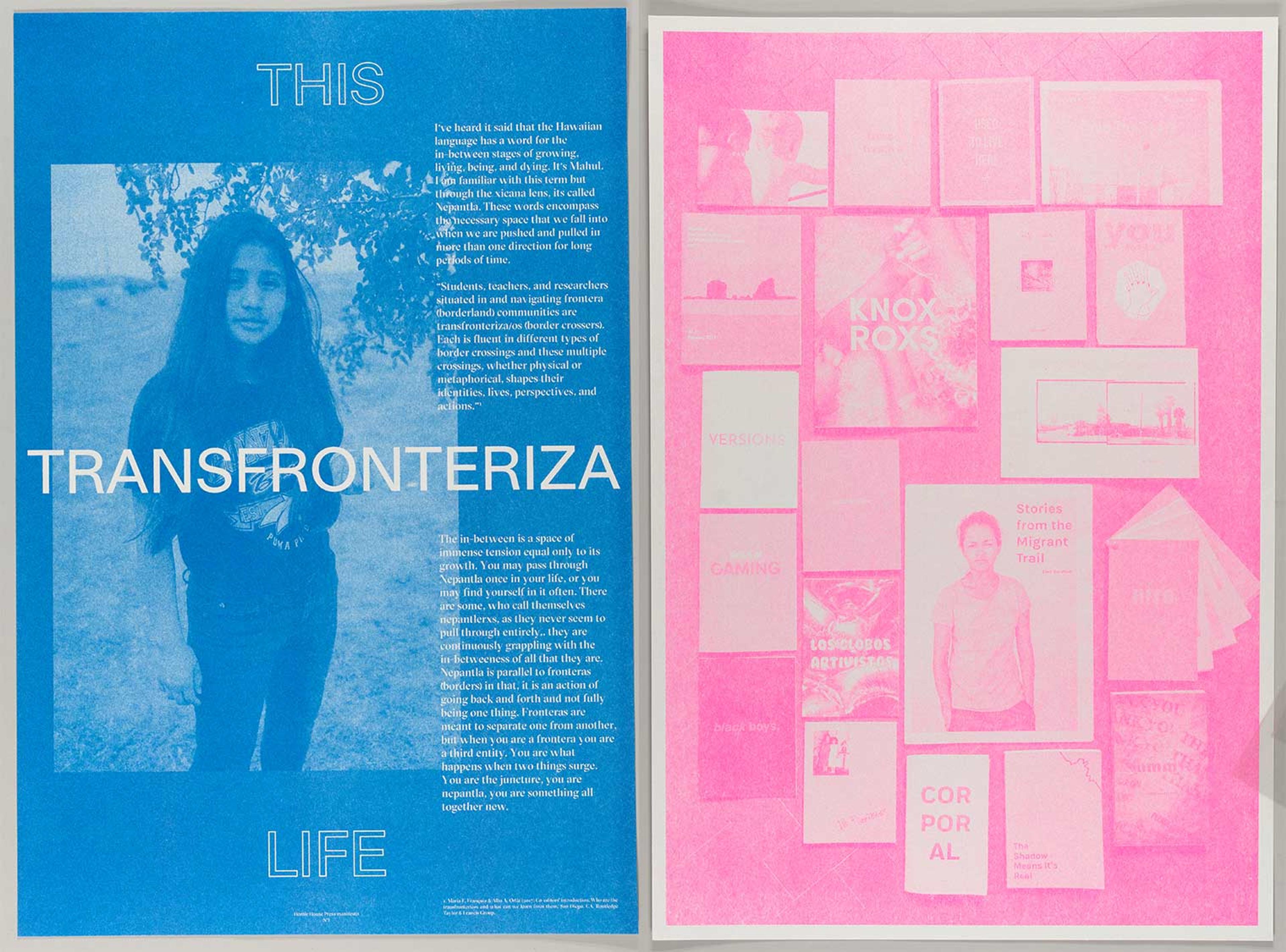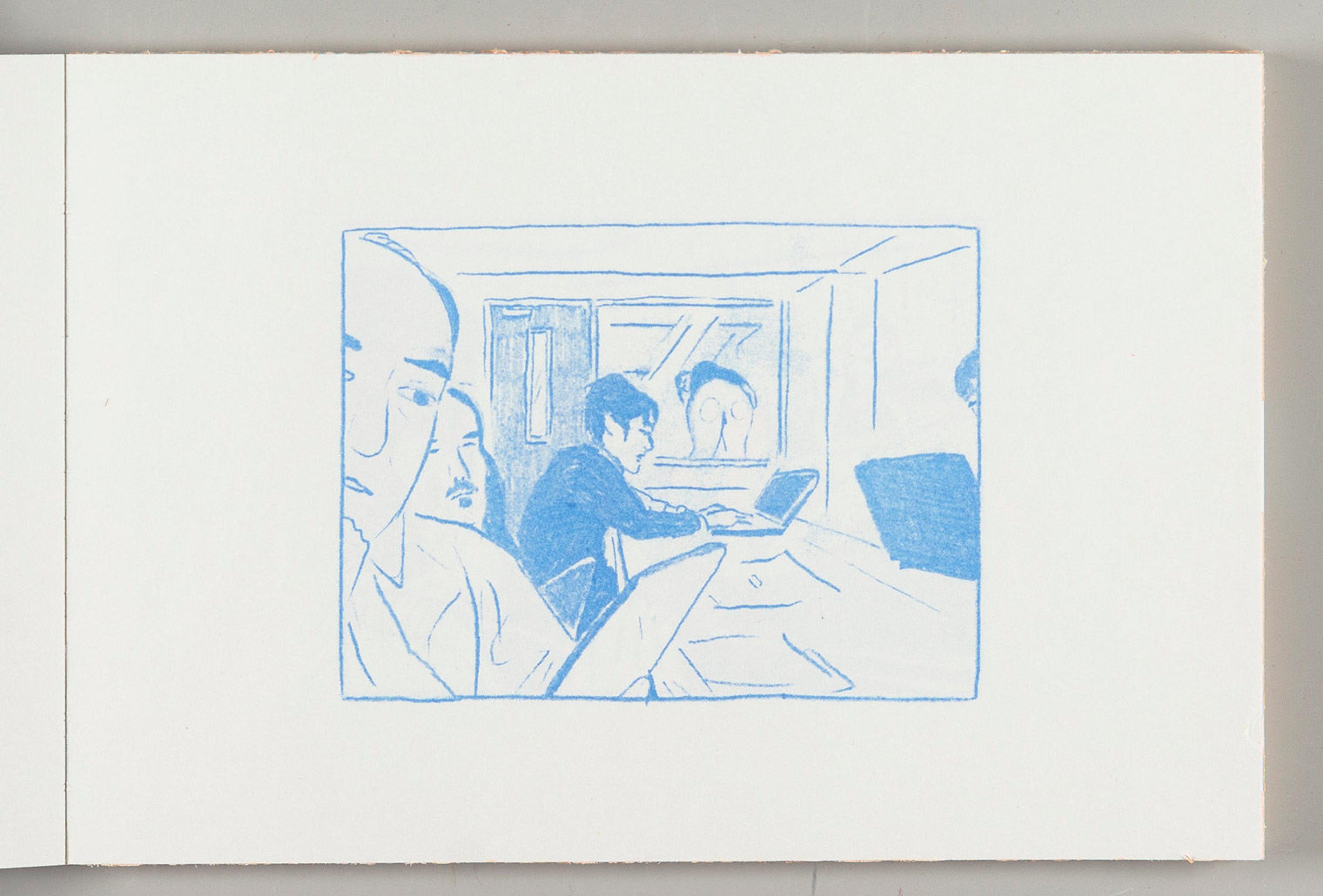I’m a cataloger in Watson Library, and increasingly I’m seeing artists’ books come across my desk that include Risographs, a relatively new and inexpensive printing technique that has been taken up by a wildly diverse set of artists. Some of these prints are brilliantly colored, grabbing your attention with a shock of color, while others arrest you with the potency of their deeply personal messages. Lukaza Branfman-Verissimio—a queer, Jewish-American, African-Brazilian artist, activist, educator, storyteller and curator—typifies the vibrancy of this printing technique, employing strikingly bold colors to convey her urgent message: BLACK DREAMS MATTER.

Lukaza Branfman-Verissimo, We Are All Speaking at the Same Time (New York City: Endless Editions, 2020). All photos by Robyn Fleming
Risographs are ink prints made on digital duplicators manufactured by the Riso Kagaku Corporation. According to the website Dribbble, Risographs can be used to create “books, zines, art prints, posters, flyers, business cards, tags, menus, postcards, greeting cards, calendars, LP record inserts, boxed card sets and more.” Part of the appeal of Risographs for artists, designers, and bookmakers is described by Dr. Daniel Martin Feige in the introduction to Sven Tillack’s new book Exploriso: Low-tech Fine Art: “risography, in its unclear status between being merely a technical procedure and a specific aesthetic, is an interesting subject for aesthetic practice as well as theory because its possibilities are far from having been explored to exhaustion.”
Part of the appeal of Risographs for me, as a cataloger, is coming across a book whose explosion of color stops you in your tracks, like in Nathaniel Russel’s Time Zone Featuring Light—the pink tunnel on the cover almost hurts your eyes it’s so bright.

Nathaniel Russel, Time Zone Featuring Light (Lisbon, Portugal: Stolen Books, 2019)
But the things that stand out most about the books that employ this technique are the diversity of artists working with it and the powerful messages they are able to communicate. For instance, Homie House Press, a “skeleton bones crew of femmes creating + publishing in the foto book medium ... [who are] holding space for and with underrepresented communities,” used Riso-prints to create their Manifesto.

Homie House Press, Homie House Press Manifesto (Beallsville, MD: Homie House Press, 2019)
Then there is Scheherazade Tillet—a Trinidadian and African American photographer, art therapist, and community organizer—whose work is featured in a five-volume series titled Plume House of Prayer Series, which includes Risographs by artists Anthony Alvarez, Colleen Gutwein, Dominique Duroseau, Nick Kline, and Tillet. Below is a Riso-printed photograph of spiritual healer Aliyah Young, one of the fifteen “girls and young women from Tillet’s A long Walk Home’s Girl/Friends Leadership Institute which empowers Black girls from Chicago to use art to advocate for themselves, other girls, and for racial and gender justice in their schools, communities, and beyond” that were featured in this book.

Scheherazade Tillet’s R-E-S-P-E-C-T from Plume House of Prayer Series (Newark, New Jersey: Shine Portrait Studio Press, 2019). Photo of Aliyah Young, spiritual healer
Tia Blassingame—a book artist and printmaker who explores the intersection of race, history, and perception—used Risographs for her book The 14 Negro Students of Noyes Academy, Canaan, New Hampshire, an “artist’s book [that] consists of a two-sided folded brochure with text by the author and nineteenth century verse by African American students of an integrated school.”

Tia Blassingame, The 14 Negro Students of Noyes Academy, Canaan, New Hampshire (New York: Primrose Press, 2019)
Hong Kong-born artist Chihoi used Risographs in his book Pink Freud, “a collection of ... erotic sketches, made while he was watching AV movies.” This is one of the tamer prints in this provocative artist’s book, which seeks to heighten the “temptation” of these erotic prints by gluing each page together, forcing the reader to cut open each page individually. And as if that weren’t enough, the publisher writes, “And to make it more tempting, we've randomly inserted 3 original sketches in the 500 copies. So good luck!”

Chihoi, Pink Freud (Taipei, Taiwan: nos:books, 2015)
Shawn(ta) Smith-Cruz, an archivist at the Lesbian Herstory Archives, uses Riso-printing in her book My Experience Processing & Exhibiting the Salsa Soul Sisters with the Lesbian Herstory Archives: A Memoir and Remembrance, which was created in response to her work on the exhibition Salsa Soul Sisters: Honoring Lesbians of Color at the Lesbian Herstory Archives.

Shawn(ta) Smith-Cruz, My Experience Processing & Exhibiting the Salsa Soul Sisters with the Lesbian Herstory Archives: A Memoir and Remembrance (New York: Endless Editions and EFA Robert Blackburn Printmaking Workshop, 2018)
We even have one of these Riso-printed books currently out on display. You can come by and see Headress 6 (below), a work by Helina Metaferia—an interdisciplinary artist working across performance, video, installation, collage, and social engagement. It was part of the exhibition Bring It Home, whose about page lays out the creative intent of the show, “Featuring BIPOC artists and designers engaged with issues of equity and identity, Bring It Home uses gift-economy strategies to enlist viewers as collaborators and expand territory for diversity. Riso-printed posters by all 10 exhibition participants are distributed free to audiences—via in-person pick up and the postal service—with the invitation to install the show themselves in private or public spaces. The project responds to shifting perspectives on art production and display, foregrounds representation of voices that have not traditionally been given space, and centers on public engagement at the nexus of the COVID era and the national conversation on social justice. The exhibition title refers to people reinventing ideas of ‘home’ during the pandemic, as well as artists claiming and disrupting visual languages with personal meaning.”

Helina Metaferia's Headress 6 from Bring It Home (Bennington, Vermont: Bennington College, [2021]). Photograph of the work as installed in the vitrine display case in Watson Library
Watson Library now has over 140 books that include Risographs, and that number is steadily growing. They are as diverse as the artists who create them: some are playful, some are political, and some are deeply personal, which is why we are so excited about continuing to collect (and catalog) them as artists continue to experiment with this printing technique.
